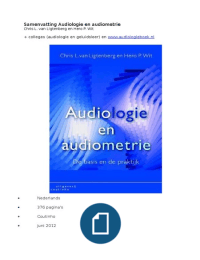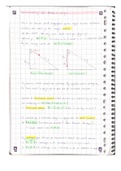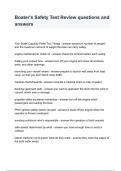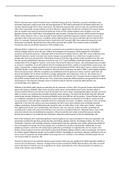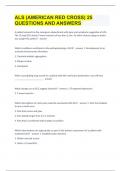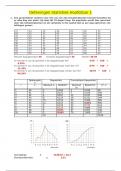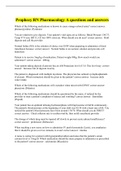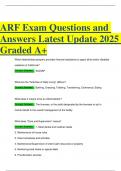Summary Heat, air and moisture transfer / CFD 1 (7LS9M0)
Summary reader HAM
Heat transfer via three mechanisms, often a combination of the three:
- Conduction: heat transfer between objects via direct contact
- Convection: heat transfer within a fluid
- Radiation: heat transfer caused by emission and absorption of electromagnetic waves by
materials, no particles involved
Heat balance in a control volume (W), differential equation conservation of
energy/Fourier’s second law , with Se The potential for heat transfer is
temperature
Fourier’s first law/heat conduction equation (flow from high to low temp)
in 3D, q in W/m2. For an isotropic material lambda is the same in all 3
directions, in that case it can be written as Change in stored heat per unit volume
For 1D qcd=dT/Rl or heat loss Q=( dT/Rl)*length in W.
Boundary conditions:
- At the interface of 2 materials (perpendicular to interface), for very high
heat fluxes this is not valid and extra contact resistance has to be added
- Into ground adiabatic (no heat flow rate/constant temp) is temp 3m below ground level 10
degrees
- Surface to air
Trcv = Te+ (absorp*Es)/he, final boundary condition:
Steady state/stationary heat conduction (time/area averaged)
2D heat flow includes thermal bridges, for 1D isotherms and heat flow lines
(show direction) are parallel. Larger heat flow near thermal bridge. Total heat flow in W/m is
increment*number of spaces
Disadvantages thermal bridge, higher heat loss, so lower surface temperatures when Te is low.
There are linear and concentrated (3D) thermal bridges. Extra heat loss thermal bridge
Thermal bridge at the corner: surface temp lower in corner due to lower air velocity and convective
heat transfer, more radiation exchange between surfaces and less with room
1D steady state heat conduction: Rc=d/λ (m2K/W), Rl=Re (0.04) + Rc + Ri (0.13), U=1/Rl or U=Q/A(Ti-
Te). Tse= Te + (Re/Rl) * (Ti-Te). For a pipe Re=1/(he*A), A=2*pi*r,
Temperature ratio (lowest admissible surf temp) or for 1D f=1-U/hi. Fn>0.65
is good. Problems for fn calculation if more than 3 temperatures and indoor surface coefficients
(smaller near floor)
,Equivalent thermal transmittance (total heat flow divided by temp drop over structure) for a thermal
bridge
Position of insulation: best for external, higher heat loss, higher U, highest surface temps
Superposition (more than 2 boundaries) calculating the combined effect of temp diff and
irradiance after each other and adding the resulting temperatures. Lowest surface temp
2 numerical methods: finite element method (triangle shape), energy balance method (rectangular)
Or Ts = (Tx/Tg) * Tg + (Tx/Te1) *Te2 + (Tx/Ti1)*Ti2
1D transient heat conduction (changes over time) with (thermal
diffusivity in m/s), larger a quicker heat transfer
Step change at surface of high heat conductivity material: C=ρ*c*d,
h/c or tau (R*C) is the time constant which is the time needed to get to 63% of the end temperature
(37% of original value), 3*tau=95%, 5*tau=99%
Temperature step change at surface of semi-infinite thick slab
Infinite thick slab has fourier number <0.18. Heat flow at the surface ,
stored heat
Interfacial temperature between two materials (from high to low)
Step in heat flow at the surface of semi-infinite thick slab, for x=0 (surface temp)
Step change in effective temperature at surface of semi-infinite thick slab:
Periodic variations, mean+ fluctuating temp with omega
= 2pi/t0 and tan(phi)=b/a in complex notation
Construction with a high heat conductivity Total temp change over R and C:
Temperature of semi-infinite thick slab exposed to fluctuating temp
the amplitude is lower deeper in construction, temp is stable at a certain depth
With penetration depth d*=37% of original amplitude and 3d= 5% left , Time shift of wave
Velocity of wave
With outside insulation, all fluctions are kept in insulation, almost no fluctuation in the construction.
With inside insulation, there is fluctiation in construction. For a stable indoor climate: much mass in
room. Intermitted heating: only heating when needed, but because of thermal mass of construction,
there is delay in heating and cooling of room
,Numerical methods: Response factor (general, quick, but only for linear problems, superposition
criterion (complete solution is sum of separate solutions), not flexible), finite element (splitting in
pieces). Fourier number: stable oscilation with small t and large x, implicitness degree 0 explicit, 1
implicit.
Irradiance E (W/m2). Diffuse grey emitters (emittance<1 and independent of wavelength). Emission
is the same for most materials, except for metals which have a lower emission. Emission is always
longwave, absorption short and longwave. Absorption depends on color, temp and incidence
wavelength . For long wave radiation For shortwave radiation transmittance is important,
for long wave not. Direct radiation exchange with reflections there is an extra exchange factor
F depends on de geometrical orientations of surface pairs
Week 1
Thermal bridges: highly conductive thermal connection between interior and exterior. Because of
the thermal connection between floor and balcony, there is a larger heat flow from the interior via
the floor to the cold exterior. Due to this, the inner surface corners will have a lower surface
temperature. Might lead to condensation and mold growth. Typical 3D effect
Solve thermal bridge, introducing a material with a lower thermal conductivity
(insulation material, 0.4 W/m*K) in between the balcony and the inner floor
Thermal infrared camera: during winter in a well-insulated dwelling the exterior
should be cold (blue), interior warm (red)
Stationary heat transfer is not time dependent, transient is time dependent
1D heat transfer is not accounting for thermal bridges, 2D does
Yearly and daily temperatures, Fourier summation used, mean temperatures
over the year (1 sine), daily fluctuations (1 sine)
Soil temperatures: highest fluctuations at surface, at 1,5 m into ground you only see the yearly
fluctuations
The RH must be lower than 80 RH to prevent mold growth. Insulate the wall at the inside to raise the
internal surface temperature, this lowers the RH during winter.
Better to have external insulation, fluctuations will be damped already at the outside, so the wall has
no fluctuations (so no change in length of materials in the walls= mechanical behavior).
Week 2
Heat conduction equation is Fourier’s law: the heat flow is positive for a declining temperature
Heat loss by conduction for 1D stationary (constant in time, dt/dx partial derivative =0),
as there is no storage of heat qin=qout, the time derivative dt/dx is 0, T=ax+b, linear function of x
, With total thermal resistance construction Rc=d/λ (thermal conductivity, also k), change Rc in RI if
you calculate it for several material layers. RI=Re+Rc+Ri (Re=0.04, Ri=0.13), from air to air. Re=1/he
(heat transfer coefficient)
Total thermal transmittance U=1/Rl
In an air cavity we have three types of thermal transport/heat transfer:
- Conduction (cd): in air. Important only in small cavities
- Convection of air, air will be heated up at the warmer side and cooled down at colder side,
circular heat flows (amount depending on width of cavity). The wider the cavity, the larger
the heat flow by convection
- Thermal radiation from surface to surface, is independent of thickness, depending on
emissivity
Rc of cavity = 0.17 m2K/W, heat flux
Temperatures in each layer in construction:
Typical Dutch wall: inner leaf 100 mm, insulaton 100mm, cavity 40 mm (R=0.17), external leaf 100
mm
Temperature ratio fn for Ts use lowest surface temperature! For 1D Fn=1-U/hi, if
fn is near 1 the insulation is good
Week 3
Fourier’s first law:
- The potential is the temperature, the driving force is the gradient
- 3 directions, x y z, partial derivative of T over x,y,z is called the gradiant of T
- Proportionality, heat flux in 3 directions, labda is constant and stands for an isotropic
material (conducting heat in 3 directions in the same way e.g. contrete, wood has a different
conductivity in 3 directions)
Conservation of energy: for a control volume and a small interval of time the sum of the heat that
enters the volume and the heat dissipated in the volume equals the sum of the quantity leaving the
volume and energy stored in the volume
-
- Differential form (limit taken for dt)
Summary reader HAM
Heat transfer via three mechanisms, often a combination of the three:
- Conduction: heat transfer between objects via direct contact
- Convection: heat transfer within a fluid
- Radiation: heat transfer caused by emission and absorption of electromagnetic waves by
materials, no particles involved
Heat balance in a control volume (W), differential equation conservation of
energy/Fourier’s second law , with Se The potential for heat transfer is
temperature
Fourier’s first law/heat conduction equation (flow from high to low temp)
in 3D, q in W/m2. For an isotropic material lambda is the same in all 3
directions, in that case it can be written as Change in stored heat per unit volume
For 1D qcd=dT/Rl or heat loss Q=( dT/Rl)*length in W.
Boundary conditions:
- At the interface of 2 materials (perpendicular to interface), for very high
heat fluxes this is not valid and extra contact resistance has to be added
- Into ground adiabatic (no heat flow rate/constant temp) is temp 3m below ground level 10
degrees
- Surface to air
Trcv = Te+ (absorp*Es)/he, final boundary condition:
Steady state/stationary heat conduction (time/area averaged)
2D heat flow includes thermal bridges, for 1D isotherms and heat flow lines
(show direction) are parallel. Larger heat flow near thermal bridge. Total heat flow in W/m is
increment*number of spaces
Disadvantages thermal bridge, higher heat loss, so lower surface temperatures when Te is low.
There are linear and concentrated (3D) thermal bridges. Extra heat loss thermal bridge
Thermal bridge at the corner: surface temp lower in corner due to lower air velocity and convective
heat transfer, more radiation exchange between surfaces and less with room
1D steady state heat conduction: Rc=d/λ (m2K/W), Rl=Re (0.04) + Rc + Ri (0.13), U=1/Rl or U=Q/A(Ti-
Te). Tse= Te + (Re/Rl) * (Ti-Te). For a pipe Re=1/(he*A), A=2*pi*r,
Temperature ratio (lowest admissible surf temp) or for 1D f=1-U/hi. Fn>0.65
is good. Problems for fn calculation if more than 3 temperatures and indoor surface coefficients
(smaller near floor)
,Equivalent thermal transmittance (total heat flow divided by temp drop over structure) for a thermal
bridge
Position of insulation: best for external, higher heat loss, higher U, highest surface temps
Superposition (more than 2 boundaries) calculating the combined effect of temp diff and
irradiance after each other and adding the resulting temperatures. Lowest surface temp
2 numerical methods: finite element method (triangle shape), energy balance method (rectangular)
Or Ts = (Tx/Tg) * Tg + (Tx/Te1) *Te2 + (Tx/Ti1)*Ti2
1D transient heat conduction (changes over time) with (thermal
diffusivity in m/s), larger a quicker heat transfer
Step change at surface of high heat conductivity material: C=ρ*c*d,
h/c or tau (R*C) is the time constant which is the time needed to get to 63% of the end temperature
(37% of original value), 3*tau=95%, 5*tau=99%
Temperature step change at surface of semi-infinite thick slab
Infinite thick slab has fourier number <0.18. Heat flow at the surface ,
stored heat
Interfacial temperature between two materials (from high to low)
Step in heat flow at the surface of semi-infinite thick slab, for x=0 (surface temp)
Step change in effective temperature at surface of semi-infinite thick slab:
Periodic variations, mean+ fluctuating temp with omega
= 2pi/t0 and tan(phi)=b/a in complex notation
Construction with a high heat conductivity Total temp change over R and C:
Temperature of semi-infinite thick slab exposed to fluctuating temp
the amplitude is lower deeper in construction, temp is stable at a certain depth
With penetration depth d*=37% of original amplitude and 3d= 5% left , Time shift of wave
Velocity of wave
With outside insulation, all fluctions are kept in insulation, almost no fluctuation in the construction.
With inside insulation, there is fluctiation in construction. For a stable indoor climate: much mass in
room. Intermitted heating: only heating when needed, but because of thermal mass of construction,
there is delay in heating and cooling of room
,Numerical methods: Response factor (general, quick, but only for linear problems, superposition
criterion (complete solution is sum of separate solutions), not flexible), finite element (splitting in
pieces). Fourier number: stable oscilation with small t and large x, implicitness degree 0 explicit, 1
implicit.
Irradiance E (W/m2). Diffuse grey emitters (emittance<1 and independent of wavelength). Emission
is the same for most materials, except for metals which have a lower emission. Emission is always
longwave, absorption short and longwave. Absorption depends on color, temp and incidence
wavelength . For long wave radiation For shortwave radiation transmittance is important,
for long wave not. Direct radiation exchange with reflections there is an extra exchange factor
F depends on de geometrical orientations of surface pairs
Week 1
Thermal bridges: highly conductive thermal connection between interior and exterior. Because of
the thermal connection between floor and balcony, there is a larger heat flow from the interior via
the floor to the cold exterior. Due to this, the inner surface corners will have a lower surface
temperature. Might lead to condensation and mold growth. Typical 3D effect
Solve thermal bridge, introducing a material with a lower thermal conductivity
(insulation material, 0.4 W/m*K) in between the balcony and the inner floor
Thermal infrared camera: during winter in a well-insulated dwelling the exterior
should be cold (blue), interior warm (red)
Stationary heat transfer is not time dependent, transient is time dependent
1D heat transfer is not accounting for thermal bridges, 2D does
Yearly and daily temperatures, Fourier summation used, mean temperatures
over the year (1 sine), daily fluctuations (1 sine)
Soil temperatures: highest fluctuations at surface, at 1,5 m into ground you only see the yearly
fluctuations
The RH must be lower than 80 RH to prevent mold growth. Insulate the wall at the inside to raise the
internal surface temperature, this lowers the RH during winter.
Better to have external insulation, fluctuations will be damped already at the outside, so the wall has
no fluctuations (so no change in length of materials in the walls= mechanical behavior).
Week 2
Heat conduction equation is Fourier’s law: the heat flow is positive for a declining temperature
Heat loss by conduction for 1D stationary (constant in time, dt/dx partial derivative =0),
as there is no storage of heat qin=qout, the time derivative dt/dx is 0, T=ax+b, linear function of x
, With total thermal resistance construction Rc=d/λ (thermal conductivity, also k), change Rc in RI if
you calculate it for several material layers. RI=Re+Rc+Ri (Re=0.04, Ri=0.13), from air to air. Re=1/he
(heat transfer coefficient)
Total thermal transmittance U=1/Rl
In an air cavity we have three types of thermal transport/heat transfer:
- Conduction (cd): in air. Important only in small cavities
- Convection of air, air will be heated up at the warmer side and cooled down at colder side,
circular heat flows (amount depending on width of cavity). The wider the cavity, the larger
the heat flow by convection
- Thermal radiation from surface to surface, is independent of thickness, depending on
emissivity
Rc of cavity = 0.17 m2K/W, heat flux
Temperatures in each layer in construction:
Typical Dutch wall: inner leaf 100 mm, insulaton 100mm, cavity 40 mm (R=0.17), external leaf 100
mm
Temperature ratio fn for Ts use lowest surface temperature! For 1D Fn=1-U/hi, if
fn is near 1 the insulation is good
Week 3
Fourier’s first law:
- The potential is the temperature, the driving force is the gradient
- 3 directions, x y z, partial derivative of T over x,y,z is called the gradiant of T
- Proportionality, heat flux in 3 directions, labda is constant and stands for an isotropic
material (conducting heat in 3 directions in the same way e.g. contrete, wood has a different
conductivity in 3 directions)
Conservation of energy: for a control volume and a small interval of time the sum of the heat that
enters the volume and the heat dissipated in the volume equals the sum of the quantity leaving the
volume and energy stored in the volume
-
- Differential form (limit taken for dt)


